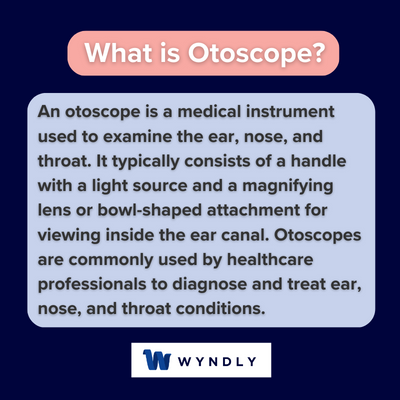What Is Otoscope? Defining Otoscope

What is an otoscope used for?
An otoscope is a medical instrument that is used to examine the inside of the ear. It has a light on the end of it that allows the healthcare provider to see inside the ear canal and look at the ear drum. Otoscopes are commonly used to diagnose ear infections and other ear conditions.
How do you use an otoscope?
To use an otoscope, the healthcare provider will first turn on the light and adjust the focus if necessary. They will then gently insert the tip of the otoscope into the ear canal, being careful not to push too hard or cause any discomfort. They will use the light to look at the ear drum and any other structures inside the ear.
Are otoscopes safe to use?
Otoscopes are generally safe to use as long as they are used properly. The healthcare provider should be gentle when inserting the otoscope into the ear and should not push too hard or cause any discomfort. It is also important to properly sterilize the otoscope after each use to prevent the spread of infections.
Can otoscopes be used on children?
Yes, otoscopes can be used on children. In fact, they are often used to examine the ears of children, particularly if the child is experiencing ear pain.
What other uses are there for otoscopes?
In addition to examining the ears, otoscopes can also be used to look inside the nose and throat. They can be helpful in diagnosing sinus infections, sore throats, and other conditions that affect these areas. Otoscopes can also be used to check for foreign objects that may be stuck in the ear or nose.
Can an otoscope be used to diagnose allergies?
An otoscope may not be the most effective tool for diagnosing allergies, as it is primarily used to examine the inside of the ear. Allergies are typically diagnosed based on a combination of symptoms, medical history, and skin or blood tests. However, an otoscope may be used to identify any ear problems that could be related to allergies, such as an ear infection or inflammation in the ear canal.
Can allergies cause ear problems?
Yes, allergies can sometimes cause ear problems. Allergies can irritate the ear canal and cause inflammation, which can lead to symptoms such as ear pain, itching, and fluid buildup. Allergies can also make you more susceptible to ear infections, which can cause further ear problems. It is important to discuss any ear symptoms with a healthcare provider to determine the cause and appropriate treatment.
What are some common allergy triggers in the ear?
Some common allergy triggers in the ear include dust mites, mold, and animal dander. Pollen from flowers and trees can also cause allergies and may contribute to ear irritation. Allergies can be triggered by contact with these substances, as well as by inhaling them. It is important to identify and avoid potential allergy triggers to prevent symptoms from occurring.
What treatment options are available for ear allergies?
Treatment options for ear allergies will depend on the specific cause of the allergies and the severity of the symptoms. Over-the-counter or prescription allergy medications may be recommended to help reduce inflammation and relieve symptoms. Allergy shots (immunotherapy) may also be recommended for long-term allergy management. In some cases, removing the allergen from the environment may be necessary to effectively manage the allergies.





